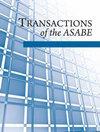恒流木屑生物反应器的技术经济分析
IF 1.4
4区 农林科学
Q3 AGRICULTURAL ENGINEERING
引用次数: 1
摘要
对不同条件下运行的多种规模的生物反应器进行了技术经济分析。单位成本随着生物反应器尺寸的增大而降低。较长hrt和旁路流量的生物反应器由于处理能力降低,单位成本增加。一个大型生物反应器比多个小型生物反应器更具成本效益。木片反硝化生物反应器是一项相对较新的前沿技术,用于减少地下排水中的硝酸盐氮(NO3-N)。影响硝酸盐去除率的因素有温度、溶解氧、水力停留时间等。本研究的目的是对四种规模的木屑反硝化生物反应器进行技术经济分析(TEA),分别在三种HRT(2、8和16 h)下运行,设计为旁路流动或低概率的旁路流动,以确定每种生物反应器规模和每种HRT下去除1 kg NO3-N的成本。我们做了几个假设:在所有尺度上都可以达到每立方米2小时HRT所需的流量,在每立方米的基础上可以实现相同质量的NO3-N去除,并且在每个尺度上2小时HRT没有任何旁通流量。根据这些假设,在16 h HRT下具有低概率旁路流动的大型生物反应器的单位成本最低,其结果成本为0.74 kg-1 NO3-N。采用旁路流设计的中试规模生物反应器的单位成本最高,达到16 h的HRT,去除NO3-N的成本为60.13美元。在旁路流量较长的hrt下,观察到硝酸盐的去除率较高,质量去除率较低。由于设计中旁路流动的概率较低,因此硝酸盐的质量去除率和去除率较高,从而得到上述结果。与这一趋势形成对比的是,大型生物反应器的总成本和年成本最高,中试规模生物反应器的成本最低。然而,确定了中试、小型和中型生物反应器的总成本将增加783%、280%和54%,以实现与一个大型生物反应器处理相同体积的流量所需的生物反应器数量(分别为66、24和4)。这些结果可用于为未来的设计决策提供信息,并告知利益相关者在一系列预期的现场条件下安装反硝化木屑生物反应器的大约单位成本。虽然一个更大的生物反应器与低可能性的旁路流动可能代表更具有成本效益的投资,但在设计时需要考虑意外的负面副产品的可能性。关键词:反硝化,硝酸盐,瓦排水,水质,木片生物反应器本文章由计算机程序翻译,如有差异,请以英文原文为准。
Techno-Economic Analysis of Constant-Flow Woodchip Bioreactors
HighlightsTechno-economic analysis was performed for multiple scales of bioreactors operated under a variety of conditions.The unit cost decreased as the bioreactor size increased.The unit cost increased in bioreactors with longer HRTs and bypass flow due to reduced treatment capacity.One large bioreactor was more cost-effective than multiple smaller bioreactors.Abstract. Woodchip denitrification bioreactors are a relatively new, edge-of-field technology used to reduce nitrate-nitrogen (NO3-N) from subsurface tile drainage. The removal rate of nitrate is influenced by many factors, including temperature, dissolved oxygen, and hydraulic residence time (HRT). The objective of this study was to conduct a techno-economic analysis (TEA) for four scales of woodchip denitrification bioreactors operating at three HRTs (2, 8, and 16 h), designed with bypass flow or with a low probability of bypass flow, to determine the cost to remove 1 kg of NO3-N at each bioreactor scale and at each HRT. Several assumptions were made: the flow rate required to achieve a 2 h HRT on a per m3 basis could be achieved at all scales, the same mass removal of NO3-N was achieved on a per cubic meter basis, and the 2 h HRT did not have any bypass flow at each scale. With these assumptions, the lowest unit cost was observed for the large-scale bioreactor sized to have a low probability of bypass flow at 16 h HRT, with a resulting cost of $0.74 kg-1 NO3-N removed. The highest unit cost was observed for the pilot-scale bioreactor designed with bypass flow to achieve a 16 h HRT at a cost of $60.13 kg-1 NO3-N removed. At longer HRTs with bypass flow, a greater percent removal of nitrate has been observed with a lower mass removal rate. By having a low probability of bypass flow in the design, a higher mass removal and percent removal of nitrate were observed, leading to the above results. Contrasting this trend, the total and annual costs were highest for the large-scale bioreactor and lowest for the pilot-scale bioreactor. However, it was determined that 783%, 280%, and 54% increases in total cost for the pilot-, small-, and medium-scale bioreactors would be incurred to implement the number of bioreactors (66, 24, and 4, respectively) required to treat the same volume of flow as one large bioreactor. These results can be used to inform future design decisions and inform stakeholders of the approximate unit cost of installing a denitrifying woodchip bioreactor over a range of expected field conditions. While a larger bioreactor with a low probability of bypass flow may represent a more cost-effective investment, the potential for unintended, negative byproducts needs to be considered in the design. Keywords: Denitrification, Nitrate, Tile drainage, Water quality, Woodchip bioreactor.
求助全文
通过发布文献求助,成功后即可免费获取论文全文。
去求助
来源期刊

Transactions of the ASABE
AGRICULTURAL ENGINEERING-
CiteScore
2.30
自引率
0.00%
发文量
0
审稿时长
6 months
期刊介绍:
This peer-reviewed journal publishes research that advances the engineering of agricultural, food, and biological systems. Submissions must include original data, analysis or design, or synthesis of existing information; research information for the improvement of education, design, construction, or manufacturing practice; or significant and convincing evidence that confirms and strengthens the findings of others or that revises ideas or challenges accepted theory.
 求助内容:
求助内容: 应助结果提醒方式:
应助结果提醒方式:


